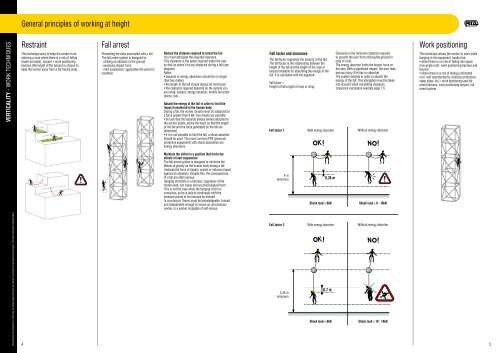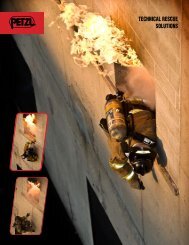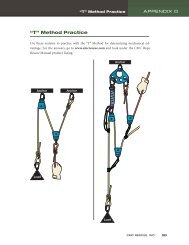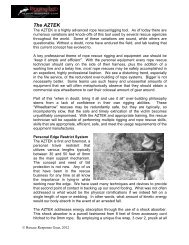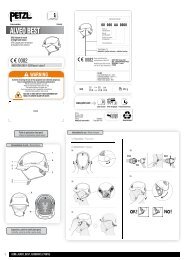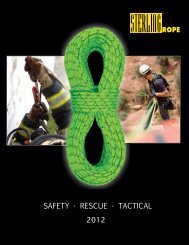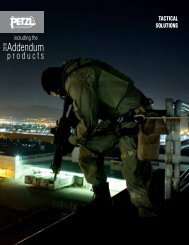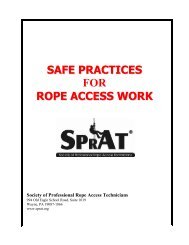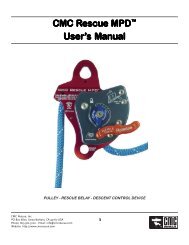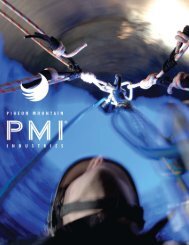VERTICALITY - LIGHTING
VERTICALITY - LIGHTING
VERTICALITY - LIGHTING
- No tags were found...
You also want an ePaper? Increase the reach of your titles
YUMPU automatically turns print PDFs into web optimized ePapers that Google loves.
<strong>VERTICALITY</strong><strong>VERTICALITY</strong> - WORK TECHNIQUES© Chris Rogl / Hoehenwerkstatt GmbHMastering the techniquesTo optimize safety and efficiency in work at height, great precisionand excellent technique are required. These skills should be acquiredthrough specific training and regular practice appropriate for each stageof the operation.Petzl recommends using a specialized training organization for alltraining activities.The examples on the following pages illustrate some of the practicesused in the vertical world.Means of protectionIn most cases, collective protection should be the first choice. The useof Personal Protective Equipment (PPE) is authorized for certain specificcases:• when the use of an external access device is not possible (platform,cherry picker, etc.)• when installing collective protection systems is technically impossible• when using PPE can reduce risks• when the tasks are temporary and short-termProviding safety during operationsUsing PPE for work at height and rescue systems must always followcertain basic rules:• careful selection and safe placement of anchor points: the quality ofthe anchors is crucial for safety. Distributing loads and installing devicesis essential. Double or triple redundant anchors for each system providean optimal level of safety, particularly for rescue operations and Tyroleantraverses• appropriate work area organization: installations for working at heightor for rescue must be simple, well-organized and regularly inspectedbefore use. Simple, well organized systems will make the inspectionprocess quicker and more efficient• a back-up belay system: whenever possible, rescue systems musthave an independent back-up system that simultaneously ensures thesafety of the victims and rescuers (except in the case of self-rescue)• an evacuation plan: at a worksite, there must be an evacuation planthat allows the teams to get themselves out or be rescued in the case ofan accident. PPE was originally designed to only be used by one personat a time. When this equipment is used to evacuate two people at thesame time, it is only authorized for a few specific scenarios, such asaccompanied descent, lowering or raising a litter, etc. In these cases:- their use is neither certified nor covered by the directive on personalfall protection- the equipment is being used at the upper limits of itscapacity: carefully read the instructions for use2 3WarningTake the time to fully read and understand the information presentedin this catalog, as well as the instructions for use that come withthe products. Gaining an adequate apprenticeship is your ownresponsibility.The information presented in this catalog is believed to be correctat press time. But it is not guaranteed to be exhaustive, correct,understandable, or up-to-date. PETZL reserves the right to modifythis information at any time. Contact PETZL if you have any doubt ordifficulty in understanding the information presented in this catalog.TechniquesWork techniquesGeneral principles of working at height page 4Rope access and confined space 6Tree care 12Energy and networks 16Framing and roofing 20Rescue techniquesGeneral principles page 24EXO self-rescue 26On-site rescue 28Technical rescue 32Ski lift evacuation 36ProductsStandards page 40Harnesses 42Helmets 58Lanyards and energy absorbers 64Mobile fall arrest device for rope 72Connectors 74Descenders 82Rope clamps 88Pulleys 94Anchors 100Ropes 106Packs 112Accessories 114Product index 142


